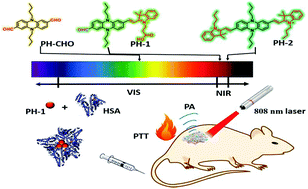NIR organic dyes based on phenazine-cyanine for photoacoustic imaging-guided photothermal therapy†
Abstract
As non-invasive diagnosis and therapy methods, photoacoustic (PA) imaging and photothermal therapy (PTT) have attracted extensive attention. Herein, two new acceptor–donor–acceptor near-infrared organic phenazine-cyanine dyes PH-1 and PH-2 were reported for photoacoustic imaging-guided photodynamic therapy. In the strong donor phenazine molecule, the electron-withdrawing indole salt unit was introduced for absorption to the near-infrared region. To improve water solubility, the two organic dyes were assembled with human serum albumin (HSA) to form nanoparticles of appropriate sizes, i.e., PH-1@HSA and PH-2@HSA, which showed excellent stability in both weakly acidic and weakly basic environments. Moreover, the results showed that PH-1@HSA and PH-2@HSA nanoparticles can effectively transform luminous energy to thermal energy in vitro and in vivo, and they can be utilized for PA imaging. Importantly, PH-1@HSA can accumulate in mice subcutaneous tumors by enhanced permeability and retention (EPR) and damage cancer tissues effectively.



 Please wait while we load your content...
Please wait while we load your content...